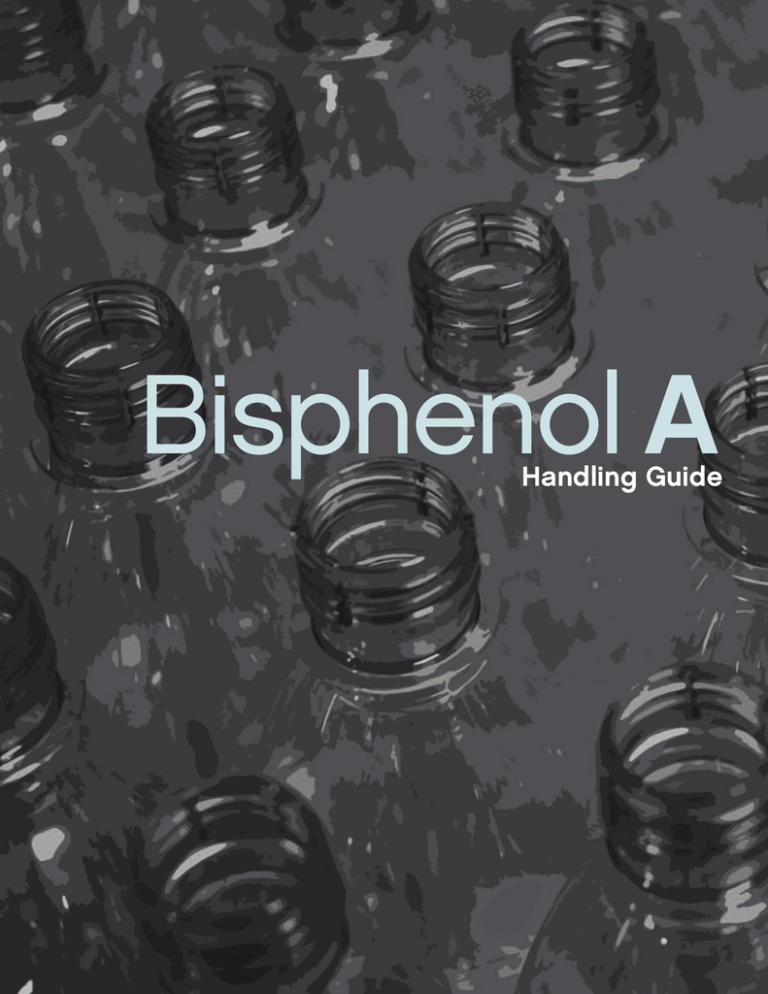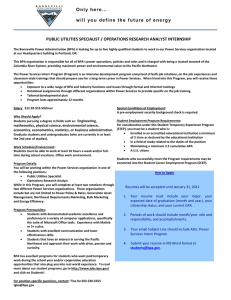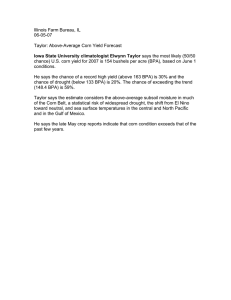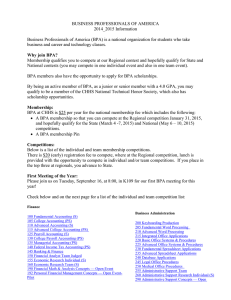
Bisphenol A
Handling Guide
Table of Contents
Introduction ................................................................................................................1
Guide Preparation ..........................................................................................1
Legal Disclaimer ..............................................................................................2
Copyright Notice ............................................................................................3
Chemical and Physical Properties ..............................................................4
Production Information ......................................................................................6
Applications and Uses ........................................................................................8
Physical Hazard Information..........................................................................11
Overview of Potential Health Effects........................................................13
Exposure Potential ..............................................................................................17
First Aid ....................................................................................................................19
Workplace Health and Safety ......................................................................21
Engineering Controls..................................................................................21
Product Handling and Transfer............................................................21
Storage Considerations ..........................................................................23
Personal Protective Equipment ..........................................................23
Workplace Exposure Limits ..................................................................24
Environmental Information ............................................................................27
Environmental Fate and Effects..........................................................27
Spills and Clean-up ....................................................................................27
Waste Disposal Considerations..........................................................28
Regulatory Information ....................................................................................31
Additional Information ......................................................................................33
Introduction
When handled and managed appropriately, bisphenol A (BPA)
has a low potential for hazard to workers and the environment.
In industrial settings, including facilities where BPA is used, it is
important to implement adequate measures to protect workers
and the environment.
This guidance document contains information on the handling of
BPA in industrial settings. In addition, this Guide provides information
on regulations, health effects, environmental fate and effects, and
product applications associated with BPA. It is intended to assist
those who manufacture, distribute, handle, use, and dispose of BPA
in industrial settings to support the safe handling of this material.
Although this Guide provides information on international legislative
or regulatory requirements, users of the Guide should note that this
information is very limited in scope.
Guide Preparation
As members and affiliated companies of the American Chemistry
Council, we support efforts to improve the industry’s responsible
management of chemicals. To assist in this effort, the American
Chemistry Council’s Polycarbonate/BPA Global Group prepared
and published this Guide.
1
Legal Disclaimer
The Bisphenol A Handling Guide was prepared by the American
Chemistry Council's Polycarbonate/BPA Global Group. It is intended
to provide general information to persons who may manufacture,
distribute, handle, use, store, or dispose of BPA. It is not intended to
serve as a substitute for in-depth training or specific handling or
storage requirements, nor is it designed or intended to define or
create legal rights or obligations. It is not intended to be a "how-to"
manual, nor is it a prescriptive guide. All persons involved in
handling BPA have an independent obligation to ascertain that
their actions are in compliance with current international, national
or federal, state or provincial, and local laws and regulations and
should obtain appropriate expert consultation through their
employer or legal counsel concerning such matters. The Guide is
necessarily general in nature and individual companies may vary
their approach with respect to particular practices based on
specific factual circumstances, the practicality and effectiveness
of particular actions, and economic and technological feasibility.
Any mention of specific products in this Guide is for illustration
purposes only and is not intended as a recommendation or
endorsement of such products.
Consult the manufacturer’s Material Safety Data Sheet (MSDS) or
Safety Data Sheet (SDS) for product-specific information on BPA.
Neither the American Chemistry Council, nor the individual member
companies of the Polycarbonate/BPA Global Group, nor any of
their respective directors, officers, employees, subcontractors,
consultants, or other assigns, makes any warranty or representation,
either express or implied, with respect to the accuracy or
completeness of the information contained in this Guide; nor do the
2
American Chemistry Council or any member companies assume
any liability or responsibility for any use or misuse, or the results
of such use or misuse, of any information, procedure, conclusion,
opinion, product, or process described in this Guide. NO
WARRANTIES ARE GIVEN; ALL IMPLIED WARRANTIES OF
MERCHANTABILITY OR FITNESS FOR A PARTICULAR PURPOSE
ARE EXPRESSLY EXCLUDED.
The information contained in this Guide may be periodically
updated or may be outdated. Contact your employer or the staff
manager of the American Chemistry Council’s Polycarbonate/BPA
Global Group to determine if a newer edition is available.
For more information on material presented in this Guide, please
contact your employer or BPA supplier
Copyright Notice
This work is protected by copyright. Users are granted a
nonexclusive royalty-free license to reproduce and distribute this
Guide, subject to the following limitations: (1) the work must be
reproduced in its entirety, without alterations; and (2) copies of
the work may not be sold.
Copyright © 2013 American Chemistry Council. All Rights Reserved.
3
Chemical and
Physical Properties
Consult the manufacturer’s Material Safety Data Sheet (MSDS) or
Safety Data Sheet (SDS) for product-specific information on
chemical and physical properties.
Structure
4
Chemical Name
TSCA, DSL
ASIA-PAC
EINECS
Phenol, 4,4'-(1-methylethylidene)bis4,4’-isopropylidenediphenol
4,4'-isopropylidenediphenol
Common Name
Bisphenol A (BPA)
IUPAC Name
2,2-bis(4-hydroxyphenyl)propane
CAS RN
80-05-7
Molecular Formula
C15H16O2
Synonyms
4,4'-isopropylidenediphenol
2,2-bis-(4-hydroxy-phenyl)-propane
Phenol, 4,4'-(1-methylethylidene)bis4,4'-(1-Methylethylidene)bisphenol
4,4'-dihydroxyphenyl-2,2-propane
Diphenol methylethylidene
Properties
• White to light tan solid flake, powder, prill, or crystal
• Solid at ambient conditions
• Mild phenolic odor
Molecular Weight
228.29 g/mol
Boiling Point @
atmospheric pressure
680°F (360°C); @ 4mm Hg: 428°F (220°C)
Melting Point
309-314 °F (154-157°C)
(may vary with crystalline form)
Flash Point
(Cleveland Open Cup)
405 °F (207°C)
Explosive limits (in air)
Minimum explosive concentration
0.012 g/L of air with oxygen > 5%
Auto-ignition temperature
990°F (532°C)
Vapor pressure
5.3 x10-9 kPa at 25°C
n-Octanol-water partition
coe∞cient (log Kow)
3.4
Solubility in water
300 mg/L
Oxidizing properties
Not an oxidizing agent
Specific Gravity @ 25°C
1.195
Bulk Density
600-720 kg/m3
5
BPA is commercially
manufactured via an
acid-catalyzed reaction
between phenol and
acetone in an enclosed
continuous process
under mild conditions
of temperature and
pressure.
6
The reaction mixture is then purified by distillation or crystallization,
excess reactants are recovered, and purified BPA is formed as a
free-flowing, spherical prill, granular flake, or crystal. Particle size
varies according to the type of product, ranging from approximately
0.9 mm to 1.2 mm. The primary byproduct in this process is water.
7
Applications and Uses
BPA is mainly used as a chemical intermediate, and primarily as a key
monomer in polycarbonate plastic and epoxy resin production.
Polycarbonate plastic is lightweight, durable and shatter-resistant
and is used to make a wide variety of products. It also has excellent
thermal and electrical insulation properties. It is corrosion-resistant
to many substances that attack other materials. It is inherently
transparent, making optical devices possible. The flexibility of
polycarbonate plastic, when heated, allows it to be easily molded
into complex shapes and forms, facilitating integration of different
materials and functions. Some noteworthy examples of
polycarbonate uses include:
• Sports safety equipment
• Healthcare and medical devices
• Automotive, marine and aerospace applications
• Electronic equipment (product housings, optical media)
• Building and construction
• Packaging (reusable bottles, food containers)
• Home appliance housings
• Security (bullet-resistant shielding, protective visors)
Epoxy resins have critical uses in coatings, particularly in the
automotive industry, where the resins are used in primers, topcoats,
and powder coatings. Epoxy resins are also components of food and
beverage can coatings used to protect the contents of the can and
to maintain freshness and flavors. They are also used as a protective
coating on a wide range of consumer items. Epoxy products provide
excellent adhesion and corrosion resistance properties.
9
Physical Hazard
Information
Reactivity Hazard Potential
Under ambient temperature and pressure conditions, BPA is
chemically stable. When handling BPA, avoid contact with oxidizing
materials such as peroxides and perchlorates, as they may react
violently when combined with BPA.
Fire and Explosion Hazard Potential
All solid forms of BPA are friable (in other words, easily reduced
to powder) and therefore, during processing, handling, and
transportation, may form dust. As a solid flake, powder, prill or
crystal, BPA is not flammable. Similar to other organic dusts,
powdered bulk material can present an explosive dust-air mixture,
which can result in a flammable or explosion hazard. It is important
to avoid accumulation of dust.
Under fire conditions, the smoke may contain the original
material in addition to combustion products of varying composition.
Combustion products may include, but are not limited to, phenolic
compounds, carbon monoxide, and carbon dioxide. Smoke may be
irritating, and the compounds in the smoke may present toxicity
concerns. To minimize smoke exposure, isolate the fire area and
deny unnecessary entry. Avoid contact with the material and smoke
during firefighting operations. Suitable fire extinguishing media
include foam, dry chemical, or water spray.
11
Overview of Potential
Health E≠ects
This section provides a brief overview of information pertaining
to potential health hazards associated with exposure to BPA.
A comprehensive discussion of health effects information
pertaining to BPA is beyond the scope of this Guide. For more
information, contact your employer or supplier.
Potential workplace exposure to BPA is primarily associated
with dust inhalation and skin contact. Direct exposure of the
respiratory tract, eyes or skin may result in health effects as
discussed below. Ingestion is not expected to be a primary
route of exposure for workers.
13
Overview of Potential Health E≠ects
(continued)
Inhalation
Dust and/or vapor may result in irritation to the upper respiratory tract
with symptoms of sneezing, coughing, runny nose and sore throat.
Exposure to vapors is expected to be minimal at room
temperature due to the low vapor pressure of BPA and because
BPA is a solid at room temperature.
Vapors may be generated when BPA is in the molten state. BPA
manufacturing occurs under closed conditions; therefore, the
vapors generally do not travel into the workplace atmosphere.
Skin Contact
Brief skin contact is generally non-irritating. Prolonged or
repeated exposure may result in irritation with symptoms of
reddening and itching.
Animal toxicity data suggest that BPA is not likely to act as a
sensitizer or photosensitizer in humans; however, when exposure to
BPA is combined with exposure to ultraviolet light from the sun or
other sources, a skin reaction or photosensitization may be possible
in humans.
14
Eye Contact
Exposure to BPA dust may result in irritation with symptoms of
reddening, tearing, stinging and swelling of the eye tissue.
Ingestion
BPA has low acute oral toxicity (LD50 > 2,000 mg/kg - rat). Ingested
BPA is rapidly metabolized to a biologically inactive compound that
is excreted.
Chronic Hazard
The European Union Risk Assessment (updated 2008) assessed
BPA exposure of workers and concluded that current risk reduction
measures (e.g., protective clothing and workplace safety measures)
provide adequate protection to workers. The potential for chronic
health effects relating to exposure to BPA is the subject of ongoing
scientific research. For more information concerning potential
chronic hazards from exposure to BPA, contact your employer or
supplier.
15
Exposure Potential
BPA is manufactured in a closed process. However, potential
exposure during manufacture and/or handling could occur during
sampling, bagging, loading, unloading, or plant maintenance
activities. Exposure to dust is also possible, with the most likely
exposure routes by inhalation or dermal contact.
Other concerns in the BPA manufacturing process include
potential exposure to phenol. Ensure adequate controls are in
place to reduce the likelihood of exposure to phenol.
17
First Aid
Consult and follow product-specific first aid instructions that are
provided in the MSDS/SDS. This Guide provides a general outline of
typical first aid protocols used by BPA manufacturers.
Eye Contact
Flush eyes immediately with plenty of lukewarm water for an
adequate period (typically, at least 15 minutes); hold eyelids open
while irrigating. If wearing contact lenses, flush with water first, and
remove lenses only after flushing with water. Get medical attention
if irritation develops.
Skin Contact
Remove contaminated shoes and clothing. Wash affected areas
with soap and water. Get medical attention if irritation develops. For
molten product, immediately immerse affected area in cool water or
flush with large amounts of cool water, and get medical attention.
Inhalation
If dust is inhaled, leave the area and go to an area where fresh air
is available. If breathing difficulty is experienced, seek a properly
trained person to administer oxygen. Get medical attention if signs
of respiratory tract irritation develop.
Ingestion
Do not induce vomiting unless directed to do so by medical
personnel. Seek medical attention immediately.
19
Workplace Health
and Safety
Engineering Controls
Control airborne BPA dust with appropriate engineering controls
such as local exhaust ventilation (LEV). Recognized practices such
as those suggested by the American Conference of Governmental
Industrial Hygienists (ACGIH), the National Fire Protection
Association (NFPA), or other country-specific guidance or
regulatory requirements provide guidance on well-designed
engineering controls.
Product Handling and Transfer
Use appropriate workplace controls during handling processes to
minimize dust formation. Keep dust away from heat sources, and
minimize or eliminate any ignition sources. Ignition sources can
include, but are not limited to, hot surfaces, sparks, flames, or static
charge build-up. When cleaning up BPA powder and dust, minimize
the generation of dust, for example, by using vacuums or
non-sparking tools to remove dust from surfaces. Use of proper
grounding and bonding procedures can help to reduce or eliminate
ignition potential from static charge. Antistatic bags do not completely
protect against the build-up of charges. For more information on
this topic, please refer to NFPA Standards 68, 69, 77, and 654, or
other country-specific guidance or regulatory organizations.
21
Workplace Health and Safety
(continued)
There are a number of ways to manage a transfer system. Two
possible approaches are discussed below:
• Construct the transfer system with fully conductive materials.
It is important that transfer equipment be properly bonded and
grounded to help prevent static build-up. Check the grounding
and bonding field system on a periodic basis to determine
whether it is operating properly. In addition, safety interlocks may
be considered as a mechanism to help prevent the transfer of
material in the event that a proper ground is not established.
OR
• Before transferring material into a large vessel such as a silo,
hopper, railcar, or truck trailer, purge the transfer and receiving
vessel with nitrogen. The purpose of the purge is to reduce the
oxygen content in the vessel so it is incapable of supporting
combustion. An in-line oxygen sensor is used to monitor oxygen
content of the vessel with this transfer method. Interlock
the oxygen sensor with automatic valves to help prevent the
transfer of material if the oxygen content is above established
levels. In the event that a nitrogen purge is performed by
personnel, strongly consider the use of supplied air respiratory
protection for personnel, due to the potential for an oxygen
deficient atmosphere.
Contact with heated vessels, transfer lines, instrument loops, tracing
lines, and sampling points can result in thermal burns. Thorough
external insulation of heated equipment and lines can help prevent
thermal burns.
22
Storage Considerations
Static build-up increases the risk for dust explosion. Proper grounding
of storage silos helps prevent the possibility of static build-up.
Written procedures and checklists can be valuable tools to detail
the methods used to measure the effectiveness of the grounding field.
Padding storage silos with an inert atmosphere will help reduce the
potential for dust explosion. A pressure and vacuum relief device
equipped with a flame arrester is used on the silo to maintain the
inert atmosphere.
Personal Protective Equipment
Consult and follow product-specific personal protective equipment
(PPE) recommendations that are provided in the MSDS/SDS. This
Guide provides general information about PPE selection.
It is important to use appropriate PPE when engineering controls
are not feasible. Appropriate eye and skin protection should be
worn in all BPA handling situations. When working with BPA in the
solid or dust forms, follow the specific PPE recommendations made
by your employer; these typically include work shoes, gloves, long
sleeves and pants or a protective suit. Eye protection includes
safety glasses with side shields or goggles. Use gloves that are
chemically resistant to this material (e.g., nitrile). When selecting
specific PPE, give consideration to all relevant workplace factors,
such as, but not limited to: other chemicals that may be handled;
physical requirements; frequency and duration of tasks; sensitivities
or allergies to PPE material; as well as the instructions/specifications
provided by your employer or PPE supplier.
23
Workplace Health and Safety
(continued)
Workers involved in the manufacture of BPA should follow the
specific instructions and requirements of their employers with
respect to the use of PPE. Your employer may require the use of
additional PPE when handling samples in liquid form or when
performing maintenance (e.g., changing production equipment
components, such as filters). These extra precautions are warranted
because the liquid reaction mixture used to manufacture BPA
contains solvents, particularly phenol. When handling phenol, PPE
typically includes a full chemical suit made of non-permeable
material equipped with a supplied air respirator. Skin exposure to
phenol can have dangerous health effects, so complete protection
is needed when performing a task where there may be exposure to
phenol. Consult with your employer or supplier for additional
guidance on the handling of phenol. Manufacturers of phenol may
offer a separate guidance document or PPE guidance for handling
phenol. Phenol exposure is not of concern for workers who handle
BPA as finished product in flake, powder, prill or crystal form, as the
phenol is fully consumed in the BPA manufacturing process.
When workers must access the top of a railcar or truck, appropriate
fall protection may be necessary. Consult with your employer for
company-specific requirements.
Workplace Exposure Limits
The U.S. Occupational Safety and Health Administration (OSHA) has
not established a permissible exposure limit (PEL) for BPA. Likewise,
the American Conference of Governmental Industrial Hygienists
(ACGIH) has not established a threshold limit value (TLV) for BPA.
24
There are, however, general exposure limits for dust. OSHA
established a PEL for Particulates Not Otherwise Regulated (PNOR)
of 15 mg/m3 for total dust and 5 mg/m3 for the respirable fraction;
ACGIH established a TLV for Particulates Not Otherwise Classified
(PNOC) of 10 mg/m3 for inhalable dust, and 3 mg/m3 for the
respirable fraction.
In Europe, however, exposure limits have been established for
BPA. The AGW, or “Arbeitsplatz Grenzwert,” which translates to
workplace exposure limit, is a legal limit (published in the TRGS
900) enforceable in Germany, and has been established at 5 mg/m3
for the inhalable fraction of BPA. In 2004, the EU DG Employment
Scientific Committee on Occupational Exposure Limits (SCOEL)
recommended an Indicative Occupational Exposure Limit Value
(IOELV) for BPA of 10 mg/m3 (8-hour TWA). This value has not been
formally adopted but is expected to be included in a forthcoming
IOELV Directive.
In Japan, workplace exposure limits for BPA have not been
established by the Government or the Academic Circle. However,
the Japan Society for Occupational Health established an
occupational exposure limit for organic dust (Class 3) of 8 mg/m3
for total dust and 2 mg/m3 for respirable dust.
Workplace exposure limits and other regulatory requirements
are subject to change. Check with the relevant government or
scientific authority for the most current information.
25
Environmental
Information
Environmental Fate and E≠ects
BPA is readily biodegradable and its bioconcentration potential is
low. Numerous environmental fate and toxicity studies indicate that
the current manufacturing and use patterns of BPA pose a low risk
to the environment. When released into the environment (surface
waters), aquatic toxicity tests suggest that BPA is only moderately
toxic to aquatic organisms.
Spills and Clean-up
In the event of a spill, take appropriate actions to contain the spill
and avoid contamination of soil and surface or ground water. BPA is
moderately toxicto fish on an acute basis. Avoid or minimize human
and animal contact with contaminated soil or water. Because BPA
can form an explosive dust/air mixture, remove ignition sources.
27
Environmental Information
(continued)
If a spill occurs, isolate the area. Do not allow smoking in these
areas. Take appropriate precautions to avoid creating dust. Keep
unnecessary and unprotected personnel from entering the area.
Emergency personnel should wear proper protective equipment
and follow emergency procedures carefully. The material should be
captured, collected and re-processed, or disposed of, according to
applicable national/federal, state/provincial or local regulations.
Decontaminate or dispose of PPE following spill cleanup in
accordance with guidance from your employer or supplier.
Waste Disposal Considerations
Disposal must be in compliance with all applicable international,
federal/national, state/provincial, local laws and regulations, and/or
other country-specific guidance or regulatory requirements.
28
Waste characterizations and compliance with applicable laws are
the sole responsibility of the waste generator.
For unused and uncontaminated product, methods of disposal
include, but are not limited to, permitted recycling, reclaiming,
incineration, or other thermal destruction methods.
Empty sacks or bulk sacks of BPA, unless thoroughly cleaned, are
likely to contain residual BPA. Consult with your employer or supplier
for more information about methods that may be available to clean
empty or bulk sacks. Otherwise, recycle, reclaim, incinerate, or
otherwise thermally destroy the sacks in accordance with
regulations.
29
Regulatory Information
United States
OSHA Hazard Communication Standard: This material is a
“Hazardous Chemical” as defined by the OSHA Hazard
Communication Standard, 29 CFR 1910.1200.
NIOSH Skin Notation Profile: BPA is assigned a composite skin
notation of SK:SEN for skin sensitization and photoallergy.
US Department of Transportation (DOT) Classification:
Non-regulated; transported as a non-hazardous material.
Superfund Amendments and Reauthorization Act of 1986 Title III
(Emergency Planning and Community Right-to-Know Act of 1986)
Sections 311 and 312:
• Immediate (Acute) Health Hazard
Yes
• Delayed (Chronic) Health Hazard
Yes
• Fire Hazard
No
• Reactive Hazard
No
• Sudden Release of Pressure Hazard
No
Superfund Amendments and Reauthorization Act of 1986 Title III
(Emergency Planning and Community Right-to-Know Act of 1986)
Section 313: BPA is subject to the reporting requirements of
Section 313 of Title III of the Superfund Amendments and
Reauthorization Act of 1986 and is listed in 40 CFR 372.
Canada
Canadian Controlled Products Regulations: BPA is considered a
controlled product under this regulation.
WHMIS Product Classification: D2, Subdivision B.
31
Regulatory Information
(continued)
National Pollution Release Inventory (NPRI) Requirements:
Reportable under NPRI.
Transportation of Dangerous Goods (TDG) Classification:
Non-regulated, transported as a non-hazardous material.
The Canadian Government concluded in its final screening
assessment of BPA that the substance meets one or more of
the criteria in section 64 of the Canadian Environmental
Protection Act, 1999 (CEPA 1999), and has added this substance
to its list of toxic substances (CEPA Schedule 1).
Europe
Labeling: In accordance with Annex I of Commission Regulation
(EC) No. 790/2009 and its amendments and adaptations:
Symbol: Xn
Hazard description: Harmful
Risk Phrases:
Irritating to respiratory system (R37)
Risk of serious damage to eyes (R41)
May cause sensitization by skin contact (R43)
Possible risk of impaired fertility (R62)
Harmful to aquatic organism (R52)
Safety Phrases:
In case of contact with eyes, rinse immediately with
plenty of water and seek medical advice (S26)
Wear suitable protective clothing, gloves and eye/face
protection (S 36/37/39)
32
If swallowed, seek medical advice immediately and
show this container or label (S46)
Avoid release to the environment. Refer to special
instructions/safety data sheets (S61)
Classification: Repr. Cat. 3, R62; Xi (irritant), R37, R41; R43; R52
Japan
Pollutant Release and Transfer Register / PRTR: BPA is
designated as Class I Designated Chemical Substance
Act on the Evaluation of Chemical Substances and Regulation
of Their Manufacture: BPA is designated as a Type 3 Monitoring
Chemical Substance.
Korea
Toxic Chemical Control Law (TCCL): BPA is categorized as an
Observational Chemical
Check with relevant government authorities for the most recent
information on regulatory requirements.
Additional Information
Refer to your supplier’s Material Safety Data Sheet (MSDS) or Safety Data Sheet (SDS).
For additional information about combustible dust and explosion hazards, visit the NFPA website at
http://www.nfpa.org and/or the OSHA website at http://osha.gov.
For guidance on selection of appropriate ventilation controls, see the most current edition of the
American Conference of Governmental Industrial Hygienists (ACGIH) Industrial Ventilation Manual.
4,4’-Isopropylidenediphenol (Bisphenol-A) Risk Assessment Final Report. European Commission Joint
Research Centre. June 2008, available at http://esis.jrc.ec.europa.eu.
Health Canada final screening assessment report and proposed risk management approach for Bisphenol A:
http://www.chemicalsubstanceschimiques.gc.ca/challenge-defi/batch-lot-2/bisphenol-a/index-eng.php.
Japanese Government Bisphenol A risk assessment document produced under the Comprehensive
Chemical Substance Assessment and Management Program:
http://unit.aist.go.jp/riss/crm/mainmenu/e_1-10.html.
List of MAK and BAT Values 2006. DFG, Deutsche Forschungsgemeinschaft. Copyright 2006.
WILEY-VCH Verlag GmbH & Co. KgaA, Weinheim. P17, 30,179.
This Guide can be found online at http://www.bisphenol-a.org.
33





